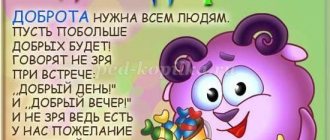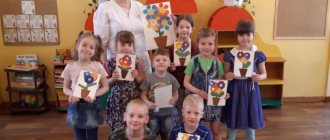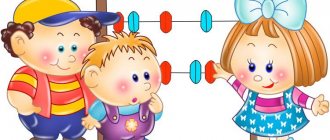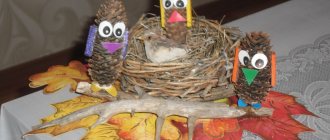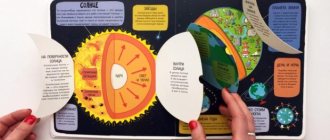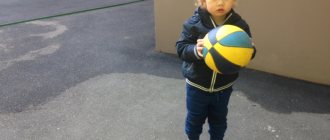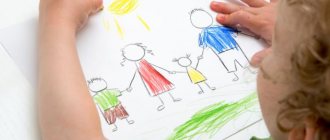Cosmonautics Day. Conversation in kindergarten. Senior group
Cosmonautics Day in kindergarten.
Author: Bondarenko Ekaterina Nikolaevna, teacher. Place of work: MBU kindergarten No. 49 “Merry notes”, Tolyatti
The theme of space is always interesting for children. Therefore, on April 12, Cosmonautics Day, educators hold holidays, competitions, and educational classes on the topic: Cosmonautics. We invite you to conduct an educational lesson for preschoolers in the form of a thematic conversation.
Thematic conversation for Cosmonautics Day “Man rose to the sky”
Objectives: 1. Generalize and expand children’s knowledge about the Universe. 2. Give an idea about the first cosmonaut, about the significance of Yuri Alekseevich Gagarin’s first flight into space, about the inventor of the space rocket, about the Cosmonautics Day holiday. 3. Form cognitive interests; the concept of oneself as an inhabitant of planet Earth. 4. Activate the vocabulary: sky, stars, planets, satellites, astronaut, Sun, Earth, Moon. 5. Enrich the vocabulary: Galaxy, Universe, Solar system, Mercury, Venus, Mars, Jupiter, Saturn, Uranus, Pluto, weightlessness, orbit, meteorite, spacesuit, lunar rover, orbital station. 6. Develop experimental activities and experimentation. 7. Foster respect and a sense of pride for the achievements of your people, based on specific historical facts. Equipment: paintings depicting the starry sky, outer space, portraits of K. E. Tsiolkovsky, S. P. Korolev and Yu. A. Gagarin, photographs of rocket launches from the Baikonur cosmodrome, photo albums about space explorers. Preliminary work: conversations about stars, planets, space and astronauts. Progress: Educator: - Many centuries passed before humanity found a way to overcome gravity and rise into outer space. Guys, remember the fairy tales and legends. What fairy-tale heroes didn't fly on! (On bats and eagles, on flying carpets and wizards’ beards, on the Little Humpbacked Horse and magic arrows...). Just a few centuries ago, no one could have imagined that the most convenient “transport” for moving around was a rocket. Mini-powder rockets have long been used to create fireworks or send signals in military affairs. In Russia, in the middle of the last century, artillery general K.I. Konstantinov gave the rocket its combat function. Its missiles could cover a distance of up to three kilometers.
The first who saw in a rocket a projectile capable of carrying earthlings into interplanetary space was the great Russian scientist K. E. Tsiolkovsky. He said this about this: “The earth is our cradle, but you cannot live forever in a cradle.” The rocket does not need air, which means it can fly in the void, in space, and reach enormous speed there. It took a lot of work to create the first rocket. It was built by Russian scientists, workers, and engineers. It was in our country that the first artificial Earth satellite was launched. Guys, do you know who the first astronaut was? What do you know about this person? When was the first space flight made? (The adult listens to the children’s answers and asks clarifying questions).
Yuri Alekseevich Gagarin first flew into space on the Vostok-1 spacecraft. His call sign “Cedar” was recognized by all the inhabitants of our planet. Although Gagarin spent only 108 minutes in space, making only one revolution around the Earth, this was only the beginning - the beginning of human exploration of outer space. Half a century has passed since then, but during this time cosmonauts from many countries, both men and women, have been in space. The first human flight into space opened the era of international space stations, the desire to explore the planets closest to Earth - Mars and Venus. Listen to how the poet Alexander Tvardovsky speaks about the day of the first flight into space in his poems. Ah, this day - the twelfth of April, How it swept through people's hearts. It seemed that the world had involuntarily become kinder, shocked by its victory. What kind of universal music he thundered, That holiday, in the motley flame of banners When the unknown son of the land of Smolensk. Was adopted by the Earth-planet. An inhabitant of the Earth, this heroic fellow, In his space vessel In a circular, forever unprecedented manner, In the depths of the sky, he waved above it... Dynamic pause “Cosmonauts” (Demonstration of physical exercises, involving children in their actions). To become an astronaut, children. From a very young age, you need to accustom yourself to order: Make your bed, do physical exercises. Let's stand straight, shoulders wider, Hands up, stay straight. From such exercises you will become stronger and stronger. Today, space flights have become completely commonplace for us, the inhabitants of the Earth. It is believed that the exploration of other planets is not far off. But the beginning of this was laid by our Russian cosmonaut. American astronaut Neil Armstrong, the first earthling to walk on the Moon, said this about Yuri Gagarin’s flight: “He called us all into space.” Show and tell about the planets.
We recommend watching:
Poems and ditties for Cosmonautics Day for kindergarten Scenario of thematic leisure time for Cosmonautics Day in kindergarten Summary of educational activities in the middle group on the topic “Oh, if only I were an astronaut” Design of a preschool educational institution for Cosmonautics Day
Similar articles:
Abstract of GCD in the senior group on the topic: Space
Scenario of thematic entertainment in the middle group for Cosmonautics Day
Sports game competition in the senior group for Cosmonautics Day
Game scenario - quizzes in the preparatory group on the topic "Space"
Summary of GCD in the preparatory group “Space Travel”
Conversation about space (senior group)
author: Averinskaya Irina Sergeevna
teacher-speech therapist MADOU kindergarten “Zvezdochka”
Conversation about space (senior group)
Conversation on the topic: “Space” (senior group)
using the presentation "COSMOS"
Goals:
Educational: to form children’s understanding of planet Earth, to introduce the first cosmonaut Yu. A. Gagarin.
Developmental: expand children’s ideas about the profession of an astronaut pilot, stimulate the development of speech, memory, thinking, develop imagination and fantasy.
Educational: to instill respect for the profession of an astronaut, to teach respect for planet Earth.
Vocabulary: Earth, sky, star, planet, sun, moon, space, rocket, astronaut.
Speech therapist:
Please tell me, do you know what holiday is celebrated in our country on April 12?
Speech therapist:
Today we will find out what kind of holiday this is!
II slide “What is space?”
Speech therapist:
Very often, people, looking at the sky, ask themselves the question: “What is there? Behind the cloud?" - Space. What is SPACE? - this is the space that surrounds our planet Earth, in which stars and planets move...
III slide
Speech therapist:
People have always wanted to know, is there life on other planets? And if there is, who lives there? But to find out, you need to fly to the planets. But how to do that?
IV slide
Speech therapist:
Almost 100 years ago, a simple teacher Konstantin Eduardovich Tsiolkovsky lived in the city of Kaluga. He loved to watch the stars through a telescope and studied them. There are many different planets and stars in outer space. And he decided to construct an aircraft that could fly to some planet. Unfortunately, he did not have the opportunity to build it.
And only many, many years later, a group of scientists made the first space satellite.
V slide
Speech therapist:
but the first to fly into outer space were not people, but animals, two husky dogs: Belka and Strelka
(consider)
VI slide
Speech therapist:
They became the first living creatures from planet Earth to stay in orbit for more than a day and return home safely.
VII slide
Speech therapist:
The first cosmonaut of the Earth was... Yuri Alekseevich Gagarin. On April 12, 1961, on the Vostok spacecraft, he went into space for the first time. Since then, this day has been celebrated in our country as Cosmonautics Day.
Speech therapist:
So what holiday is celebrated in our country on April 12?
Children:
Cosmonautics Day.
Speech therapist:
Well done! Aviation and Cosmonautics Day. Repeat again to remember.
Children repeat:
On April 12, our country celebrates Aviation and Cosmonautics Day.
Speech therapist:
And why on this day – April 12?
Speech therapist:
On April 12, our cosmonaut flew into space for the first time.
VIII slide
Speech therapist:
Do you remember the name of the first cosmonaut?
Children:
Yuri Gagarin
Speech therapist:
Well done!
Phys. minute "Cosmonauts"
(
coordination of speech with movements
)
Speech therapist:
Let's play, fly on a rocket
| I want to become an astronaut, I’ll fly on a rocket, | Bring your arms up above your head. |
| I will wrap it around the earth | Run in a circle - turn in the opposite direction |
| I'll land far away from everyone. | Run around the room, sit down. |
IX slide
Speech therapist:
What do you think an astronaut should be like?
Children:
strong, courageous, resilient, resourceful, hardworking, intelligent, quick-witted, self-possessed, etc.
X slide
Speech therapist:
You correctly said that an astronaut must be strong and resilient, because the suit he puts on during the flight weighs almost 100 kilograms. Maybe you know what it's called?
Yes, it's called SUITSUIT.
Consider the costume of the first cosmonaut and a modern spacesuit (on the slide)
Explain that the astronaut needs a spacesuit for breathing (oxygen supply), maintaining the required body temperature, and radio communications.
XI slide
Speech therapist:
And this is how astronauts from space see our planet.
And they call it “Blue Planet”. Think - why? (brown color is mountains, earth; green is forests, and blue is water - seas, oceans... Most of the planet Earth is occupied by water - that’s why there is so much blue color - that’s why they call it BLUE)
Speech therapist:
guess the
riddle riddle:
A man is sitting in a rocket.
He boldly flies into the sky, and towards us in his spacesuit
He's looking from space.
XII slide
Speech therapist:
Let's divide the word COSMONAUT into syllables
Children:
(
divided into syllables)
– clapping hands, chin control
(child’s choice)
Speech therapist: (syllable analysis)
— What is the 1st syllable?
- 2nd syllable?
- 3rd syllable?
— How many syllables are there in the word COSMONAUT?
Similarly, divide into syllables and do a syllabic analysis of the words: SPACE, ROCKET, SATELLITE, LANDING
XIII slide
Speech therapist:
I will read the poem “Rocket”, and in the evening, to please mom and dad, we will learn it.
Conversation about space (senior group)
Conversation dedicated to Cosmonautics Day in the middle group on the topic: “About space for children”
Conversation about space. Lesson in the middle group.
On the topic: “The Road to the Stars”
PERFORMED:
Mishchenko O.I
Tasks:
Introduce children to
Cosmonautics
. Expand your horizons
children.
Enrich your vocabulary: planet, astronaut
, spacesuit
Material:
pictures about
space
.
Progress of the conversation
:
Guys, have you ever looked at the sky? What did you see there?
(children's answers)
People have been looking at the sky and admiring the stars
.
They are very interested to know what they are like. Do you want to know about the stars
?
To learn about the stars
, people built
a space rocket
. AND
were the first to be sent into space
: Belka and Strelka, and when they returned, people also wanted to get closer to
the stars
.
Yu went
next to look at .
A. Gagarin is the first cosmonaut
.
In space
very, very cold.
If you go into space without
a special suit, you can instantly freeze and turn into ice.
In addition, there is very little air in space
and an ordinary person will not be able to breathe there.
That is why the astronaut
who flew into
space
was put on such a spacesuit.
The suit is very warm and protects the astronaut from the cold even in space
. In addition, a person can breathe in a spacesuit; it supplies the person with air.
When the astronaut boarded the rocket
, the countdown began: “Five, four, three, two, one, START!”
The rocket took off, fire bursting from its tail - its engine was working so hard. And the rocket flew high into the sky. She rose higher and higher. And so the rocket ended up in outer space
.
Look what the astronaut
when he found himself in it.
This is our planet Earth - we live on it. As you can see, it is round and looks like a big ball. Our planet is very, very large. We don’t notice that it looks like a ball. But if you rise high, high above the earth, then from space we will see it like this
like in this picture. Look how beautiful our planet is!
What do you think is blue on our planet? (children's answers)
.What's green?
Brown? (children's answers)
Look, this is a small ball near the earth - the moon. Moon
much smaller than earth and in space
it also looks like a ball.
And this is how the astronauts saw our Sun
. Huge
glowing fireball. But astronauts cannot
they could - because the Sun is very, very hot. If you get too close to it, you might even burn out.
And also astronauts
saw other planets that revolved around the sun. Look, this picture shows all the planets that revolve around the Sun.
Notice how huge our sun is! It is larger than all other planets! And our planet Earth - here it is - the third from the Sun - is very small compared to other planets. All planets in the solar system revolve around the Sun in their orbit. On those planets that are very close to the Sun it is very hot! We couldn't have stayed there for even a second! And on the most distant planets - which are far from the Sun - on the contrary, it is very cold, because the sun's rays do not reach there well.
Conversation in the preparatory group on the topic: “This mysterious space”
municipal budgetary preschool educational institution kindergarten No. 3 of the city of Sychevka
Conversation in the preparatory group on the topic: This mysterious space"
Educator
Kozlova Anna Sergeevna
Target
:
- introduce the symbolism of the constellations,
- arouse interest in outer space;
- expand children's understanding of the astronaut profession,
- cultivate respect for this profession;
- develop imagination and fantasy.
Progress of the lesson
Teacher: (the teacher’s questions are accompanied by the children’s answers)
Guys, do you like to look at the sky at night? What can you see in the sky? (Stars, Moon.) How many stars are there in the sky? There are countless of them. On a cloudless, clear evening, the sky above our head is strewn with many stars. They appear to be small sparkling dots because they are very far from the Earth. In fact, the stars are very large. The stars have their own names: Polaris, Sirius, Vega, etc. The stars connect into constellations, which also have their own names: Aries, Taurus, Gemini, Cancer, Leo, Virgo, Libra, Scorpio, Sagittarius, Capricorn, Aquarius, Pisces.
Educator
: Space has always interested people. Is there air on other planets? Is there life?
And so scientists, under the leadership of designer S. Korolev, invented the first satellite, installed instruments on it, and launched it into outer space. The flight was successful. Scientists decided to repeat the flight, but with living creatures on board - these were two husky dogs: Belka and Strelka, who returned safely to Earth. And then scientists decided to fulfill their cherished dream - to send a man into space.
On April 12, 1961, this dream came true. For the first time in the world, cosmonaut Yuri Gagarin made a successful flight around the Earth on the Vostok spacecraft. This was a huge joyful event not only for our country, but for all humanity. All the people of our planet joyfully welcomed the first cosmonaut.
Soon, Gagarin’s feat was repeated by the second cosmonaut, G. Titov. And then the astronaut crews began to increase. 2-3 cosmonauts began to go on space flights. But another interesting event awaited us: the world’s first female cosmonaut, V. Tereshkova, went on a space flight. And then the second female cosmonaut - S. Savitskaya. Many cosmonauts looked at our Earth from space, and among them our fellow countryman Konstantin Feoktistov. During the flight, astronauts see and observe a lot of interesting things and work a lot. They conduct medical and technical observations, study the Earth's surface and report to Earth about places where minerals have been discovered, report the approach of hurricanes, typhoons, natural disasters, fires in the taiga, clarify the weather forecast, and provide space radio and television communications . This is how complex and interesting the work of astronauts is.
At home with a book and in kindergarten
Boys dream, girls dream
Fly to the moon.
They persistently dream about the moon
And they even fly... but only in their dreams.
Educator:
Would you guys like to become astronauts? What do you think an astronaut should be like?
Children's answers
: Healthy, strong, knowledgeable, hardworking, courageous, hardy, persistent, etc.
Educator:
Listen, I’ll tell you about the tests that astronauts must go through on Earth in order to cope with similar loads in space.
Imagine if one of you were placed in a huge ball, and a huge giant began to throw it from one hand to the other. How would that make you feel? (children's answers)
And here’s another test: the astronaut is put in a chair, fastened with belts, and the machine begins to circle this chair with terrible speed: up, down, this way, that way.
And here's another thing: when the rocket takes off, it shakes a lot. To get used to this, the astronaut is put into a vibrator machine, and the shaking begins so much that you can’t hit a tooth.
The tests are very serious, but all astronauts cope with them easily. Why do you think?
Children's answers
: Because the astronauts are healthy, strong, trained, and play sports.
Educator
: All cosmonauts are masters of sports. They run, jump, and play various sports every day.
Guys, after my story, you will probably be afraid to join the cosmonaut corps? To be ready for the flight, we will also conduct this training.
An outdoor game for attention “Do this and don’t do that...”
Educator:
Well done! Everyone succeeded, everyone is enlisted in the cosmonaut corps. Now we need to decide what the astronaut needs during the flight.
Game “What objects will the astronaut take on flight.”
Educator
: So, we went through the training and took the necessary things. What else are we missing?
Children's answer: Rockets.
Educator: We will build the rocket according to this plan. We will build from chairs.
Children build a rocket and sit down.
Educator:
Children, sit down comfortably, soon you will take off, and I will remain on Earth and will monitor your flight.
(Children count from ten to one and take off with the command “Start!”...)
The rocket soared into the sky
And at that very moment she rushed off.
Only a stripe in the blue sky,
It remained white like snow.
Goodbye guys, have a nice trip!
Role-playing game "Cosmonauts".
